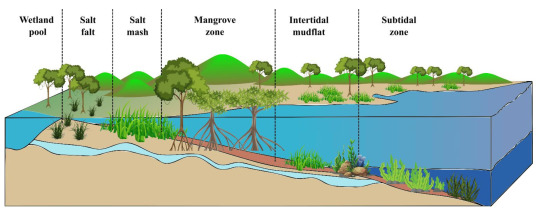#entryoftheweek
Explore tagged Tumblr posts
Text
Coastal Guardians
Hello lovely reader! Before we get into this week's topic, I have something exciting to share HEHE .
I've had the opportunity to see some mangroves myself at Kuching Wetlands National Park last month! Also got to see dolphins but wasn't quick enough to whip out my camera to record. Overall, it was a nice break from staring at texts and numbers all day :]
If you're interested you might want to consider Borneo as your next holiday destination (specifically Sarawak).
ALRIGHT let's dive right in!

Mangrove is well-known as a salt-tolerant wetland species of tree that is easily identified with its aerial roots (Bahmanabadi 2022). It is a forest that is typically at the coast line beside land and sea. The weaken the force of waves and serve as a shielding medium, hence the nickname - Coastal Guardians. These unique ecosystems are primarily found in tropical and sub-tropical coastal regions (Bandh et al. 2023) and are considered the sole "blue carbon" forests, believed to have evolved approximately 114 million years ago (Bandh et al. 2023).

Protecting coastlines
In addition, they act as nature’s own sponges, retaining extra water to stop inland floods, releasing small droplets into the atmosphere to cool the temperature down (Expert Insights 2023).
The mangrove ecosystem offers many essential environmental services, which include shielding coastline against wind, waves, and water currents; mitigation of damages done by hurricanes and tsunamis as well as soil erosion prevention and sediment accumulation (Expert Insights 2023).
In addition, mangrove forests reduce wave height by about 31% (Ahmad Mustafa Hashim, Catherine and Husna Takaijudin 2013), thus helping to prevent devastating floods that could otherwise damage homes, assets and infrastructure. In fact, several studies have shown that nearly 66% of the energy from waves is absorbed by the first one hundred meters of mangroves in a coastline (Mclvor et al. 2012; Menendez et al. 2020).
Supporting bio-diversity
Mangrove trees have unique aerial rooting systems that acts as nutrient cyclers and a breeding ground for fish and other marine life. The mangrove ecosystem has a huge biodiversity with many birds and other animal species. It also supports a unique community of fungi, microorganisms, plant species, with higher animals such as migratory birds (Kandasamy and Bingham 2001).
Moreover, mangroves are essential nurseries to many marine animals such as shrimps, crabs, and different varieties of fishes. They serve as a vital interface between coastal and terrestrial ecosystems, providing support for a diverse range of species, including those from terrestrial, estuarine, and marine environments (Kandasamy and Bingham 2001).
Mitigating climate change
Another remarkable feature of mangroves lies in their capacity to sequester carbon at a rate four times higher than that of rainforests. They draw in carbon dioxide from the air for photosynthesis which is stored within their biomass and sediment. In waterlogged mangrove habitats, decomposition is slowed down which allows it keep the carbon for longer periods of time (Chatting et al. 2022).

Even though we understand how important mangroves are for a healthy environment, they are facing a serious threat globally.
"My only wish now is that the government takes efforts to preserve the dwindling mangrove forests. They wrongly think developing forests is dead investment, that it fetches no returns. After decades of effort, people now realize the blessings these trees can bring. The mangrove trees in private lands also should be preserved.” - Kallen Pokkudan (Mangrove Man)
He was an environmental activist who was prominent in India’s mangrove conservation and was committed to conserving mangrove vegetation in Kerala region of the Indian coastline. His specialisation was to educate people about mangrove conservation and their significance in shielding coast regions from catastrophes including tsunamis and landfall hurricanes. These moves won Kallen Pokkudan recognition and respect as a defender of Indian mangroves.
The latest findings from the Global Mangrove Alliance present a troubling scenario: 67% of mangroves have already suffered damage or vanished, and an additional 1% is disappearing annually. This ongoing pattern places mangroves in significant jeopardy of total eradication. An initiative taken by the Global Mangrove Alliance seeks to mobilise $10 billion in investments to reach their goal of increasing the mangrove habitat by 20% by 2030. These investments are intended to enhance the resilience of coastal communities and enhance the quality of life for an additional 10 million individuals through various restoration and conservation initiatives.
References:
Ahmad Mustafa Hashim, Catherine, SMP and Husna Takaijudin 2013, 'Effectiveness of mangrove forests in surface wave attenuation: a review', Research Journal of Applied Sciences, Engineering and Technology, vol. 5, no. 18, pp. 4483 - 4488.
Bahmanabadi, Y 2022, Mangroves are powerful coastal guardians, Saratosa, viewed 14 October 2023, <https://www.sarasotamagazine.com/travel-and-outdoors/2022/11/mangroves>.
Bandh, SA, Malla, FA, Qayoom, I, Mohi-Ud-Din, H, Butt, AK, Altaf, A, Wani, SA, Betts, R, Truong, TH, Pham, NDK, Cao, DN & Ahmed, SF 2023, 'Importance of blue carbon in mitigating climate change and plastic/microplastic pollution and promoting circular economy', Sustainability, vol. 15, no. 3, p 2682.
Chatting, M, Al-Maslamani, I, Walton, M, Skov, MW, Kennedy, H, Husrevoglu, YS and Vay, LL 2022, 'Future mangrove carbon storage under climate change and deforestation', Frontiers in Marine Science, vol. 9, no. 781876, pp. 1 - 14.
Expert Insights 2023, The vital role of mangroves in mitigating disasters, Tidal Basin, viewed 14 October 2023, <https://www.tidalbasingroup.com/the-vital-role-of-mangroves-in-mitigating-disasters/>.
Kandasamy, K and Bingham BL 2001, 'Biology of mangroves and mangrove ecosystems', Advances in Marine Biology, vol. 40, pp. 81 - 193.
Mclvor, AL, Möller, I, Spencer, T and Spalding, M 2012, 'Reduction of wind and well waves by mangroves', Natural Coastal Protection Series: Report 1, Cambridge Coastal Research Unit Working Paper 40, pp. 1-27.
Menendez, P, Losada, IJ, Torres-Ortega, S, Siddharth, N and Beck, MW 2020. 'The global flood protection benefits of mangroves', Scientific Reports, vol. 10, no. 4404, pp. 1 - 11.
WWF n.d., The global mangrove alliance: uniting to conserve and restore valuable coastal forests, WWF, viewed 14 October 2023, <https://www.worldwildlife.org/projects/the-global-mangrove-alliance-uniting-to-conserve-and-restore-valuable-coastal-forests>.
9 notes
·
View notes